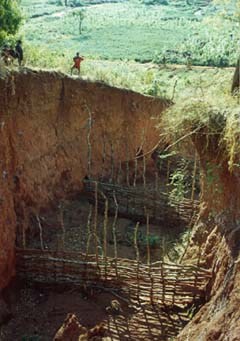> Environment in UNHCR (Switzerland), Vol 7, No.1, June 2002
Mtendeli Camp in western Tanzania was opened in 1996 for an initial group of 47,000 refugees from Burundi. Located in the catchment area of the Nyabiyoka stream, which is the main source of water for nearby Tanzanian communities as well as Mtendeli and Karago refugee camps, the site is characterized by a combination of hills (with soils that are susceptible to soil erosion) and lowlands prone to flooding.
Establishment of the camp, which has resulted in the removal of some vegetation cover as well as soil compaction on account of the population pressure has had some slight impacts on the immediate area. Rather more serious has been the parallel alignment of roads along the slope, leading to soil erosion along the roadsides and adjacent ditches, and the unfortunate expansion of a trench intended to remove water from the main road along the camp to the Nyabiyoka stream. Subsequent erosion meant that the initial shallow trench grew in just a few seasons to a 1.75km gulley that reached a depth of 12m in places and ranged from 3-7m in width. In addition to posing a serious environmental threat, children playing near this gulley were in danger of falling in and being injured or drowned. The gulley also started to serve as a convenient dumping ground for solid waste, which led to water contamination and disease during the wet season when this was washed into the main stream.
Realizing the dangers this posed UNHCR, working with the Relief to Development Society - a national non-governmental organization in Tanzania - started an anti-erosion project aimed at:
- reducing the rate of land degradation in Mtendeli;
- rehabilitating areas impacted by soil erosion;
- mobilizing, educating and sensitizing the community on soil and water conservation technologies in and around the camp;
- improving the water quality and level of water in the nearby Nyabiyoka stream;
- improving the overall health of the refugee community;
- reducing the number of accidents and deaths of children playing around the gulleys; and
- helping restore good relations between the refugee community and local populations.
Contour bands have been excavated along a distance of 16km within the camp, the intention being to slow down the rate of water run-off, one of the main contributing factors to erosion. These bands will be further stabilized with trees and local grasses.
Significant efforts are also underway to construct a series of gabions to prevent further expansion of the gulleys and to repair damage already done. Forty concrete and wire gabions and 12 wooden gabions are already in place along the length of the trench - about one-fifth of the total number of these structures needed to complete the work. These structures play an essential role in breaking up the flow of water in the gulleys and cause natural materials - silt, leaves, stones - to accumulate behind the structures, thereby also helping to fill in the channels.
While the results of this intervention are already impressive and appear to be having several positive impacts in terms of rehabilitation and improved maintenance of local soils, much remains to be done in order to complete the work before the next rains.
